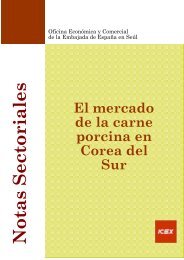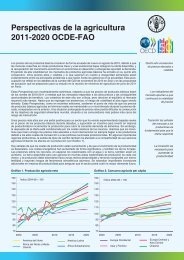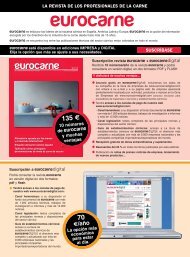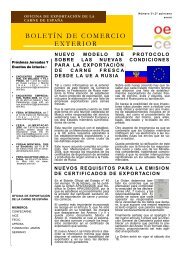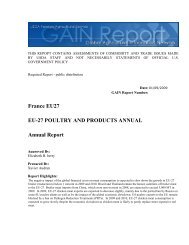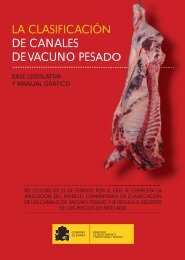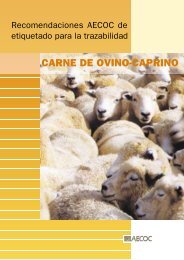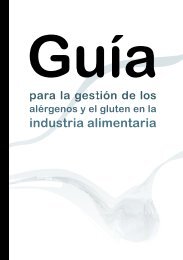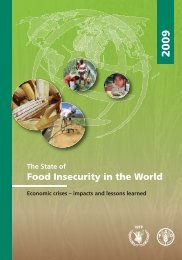figure 4-1. three ways to Make at least half of total grains whole grains a1. 3 ounces of 100% whole grains and 3 ounces of refinedgrain products100% 100% 100% 0% 0% 0%2. 2 ounces of 100% whole grains, 2 ounces of partly wholegrain products, band 2 ounces of refinedgrain products100% 100% >51% >51% 0% 0%3. 6 ounces of partly wholegrain products>51% >51% >51% >51% >51% >51%a. Each one-ounce slice of bread represents a 1 ounce-equivalent ofgrains: 1 one-ounce slice bread; 1 ounce uncooked pasta or rice; 1/2cup cooked rice, pasta, or cereal; 1 tortilla (6" diameter); 1 pancake (5"diameter); 1 ounce ready-to-eat cereal (about 1 cup cereal flakes). Thefigure uses an example <strong>for</strong> a person whose re<strong>com</strong>mendation is 6 ouncesof total grains with at least 3 ounces from whole grains per day.b. Partly whole-grain products depicted are those that contributesubstantially to whole-grain intake. For example, products that contain atleast 51% of total weight as whole grains or those that provide at least 8grams of whole grains per ounce-equivalent.nutrient adequacy, individuals who consume all of theirgrains as whole grains should include some that havebeen <strong>for</strong>tified with folic acid, such as some ready-toeatwhole-grain cereals. This is particularly important<strong>for</strong> women who are capable of be<strong>com</strong>ing pregnant.The re<strong>com</strong>mendation to consume at least half oftotal grains as whole grains can be met in a numberof ways (Figure 4-1). The most direct way to meetthe whole grain re<strong>com</strong>mendation is to eat at leasthalf of one’s grain-based<strong>for</strong> More in<strong>for</strong>Mationappendix 4, using thefood label to trackcalories, nutrients, and ingredients,lists some of thewhole grains available in theUnited States and explainshow to use the ingredientslist to find whole grains.foods as 100% wholegrainfoods. If the onlygrains in the ingredientslist are whole grains, thefood is a 100% wholegrainfood. The relativeamount of grain in thefood can be inferred bythe placement of thegrain in the ingredients list. The whole grain shouldbe the first ingredient or the second ingredient, afterwater. For foods with multiple whole-grain ingredients,they should appear near the beginning of theingredients list.Many grain foods contain both whole grains andrefined grains. These foods also can help peoplemeet the whole grain re<strong>com</strong>mendation, especiallyif a considerable proportion of the grain ingredientsis whole grains. For example, foods with at least 51percent of the total weight as whole-grain ingredientscontain a substantial amount of whole grains.Another example is foods with at least 8 grams ofwhole grains per ounce-equivalent. 63 Some productlabels show the whole grains health claim 64 or thegrams of whole grain in the product. This in<strong>for</strong>mationmay help people identify food choices that have asubstantial amount of whole grains.63. Adapted from the Food Safety and Inspection Service (FSIS) guidance on whole-grain claims. Available at http://www.fsis.usda.gov/OPPDE/larc/Claims/Food_Guide_MyPyramid_Policy.pdf.64. Products that bear the FDA health claim <strong>for</strong> whole grains have at least 51% or more of the total ingredients by weight as whole-grain ingredients, as wellas meet other criteria.37DIETARY GUIDELINES FOR AMERICANS, 2010 | Chapter Four
Milk and Milk Products 65Milk and milk products contribute many nutrients, suchas calcium, vitamin D (<strong>for</strong> products <strong>for</strong>tified with vitaminD), and potassium, to the diet. Moderate evidenceshows that intake of milk and milk products is linked toimproved bone health, especially in children and adolescents.Moderate evidence also indicates that intakeof milk and milk products is associated with a reducedrisk of cardiovascular disease and type 2 diabetes andwith lower blood pressure in adults.Intake of milk and milk products, including <strong>for</strong>tifiedsoy beverages, is less than re<strong>com</strong>mended amounts<strong>for</strong> most adults, children and adolescents ages 4to 18 years, and many children ages 2 to 3 years.Re<strong>com</strong>mended amounts are 3 cups per day offat-free or low-fat milk and milk products <strong>for</strong> adultsand children and adolescents ages 9 to 18 years, 2 1 /2cups per day <strong>for</strong> children ages 4 to 8 years, and 2cups <strong>for</strong> children ages 2 to 3 years. (See Chapter 5<strong>for</strong> specific in<strong>for</strong>mation and re<strong>com</strong>mendations.) Ingeneral, intake is lower <strong>for</strong> females than <strong>for</strong> malesand declines with age.The majority of current fluid milk intake <strong>com</strong>esfrom reduced fat (2%) or whole (full-fat) milk, withsmaller amounts consumed as fat-free (skim) orlow-fat (1%) milk. Almost half of the milk and milkproduct intake in the United States <strong>com</strong>es fromcheese, little of which is consumed in a lowerfat<strong>for</strong>m. Choosing fat-free or low-fat milk andmilk products provides the same nutrients withless solid fat and thus fewer calories. In addition,selecting more of milk group intake as fat-free orlow-fat fluid milk or yogurt rather than as cheesecan increase intake of potassium, vitamin A, andvitamin D and decrease intake of sodium, cholesterol,and saturated fatty acids.It is especially important to establish the habit of drinkingmilk in young children, as those who consume milkat an early age are more likely to do so as adults. Forindividuals who are lactose-intolerant, low-lactose andlactose-free milk products are available. Those who donot consume milk or milk products should consumefoods that provide the range of nutrients generallyobtained from the milk group, including protein,calcium, potassium, magnesium, vitamin D, and vitaminA. Soy beverages <strong>for</strong>tified with calcium and vitamins Aand D are considered part of the milk and milk productsgroup because they are similar to milk both nutritionally66 and in their use in meals.Protein foodsProtein foods include seafood, meat, poultry, eggs,beans and peas, soy products, nuts, and seeds. Inaddition to protein, these foods contribute B vitamins(e.g., niacin, thiamin, riboflavin, and B 6 ), vitaminE, iron, zinc, and magnesium to the diet. However,protein also is found in some foods that are classifiedin other food groups (e.g., milk and milk products).The fats in meat, poultry, and eggs are consideredsolid fats, while the fats in seafood, nuts, and seedsare considered oils. Meat and poultry should be consumedin lean <strong>for</strong>ms to decrease intake of solid fats.are seafood and fish the saMe?Seafood is a large category of marine animalsthat live in the sea and in freshwater lakes andrivers. Seafood includes fish, such as salmon,tuna, trout, and tilapia, and shellfish, such asshrimp, crab, and oysters.Some <strong>Americans</strong> need to increase their total intakeof protein foods, while others are eating more than isre<strong>com</strong>mended. <strong>Americans</strong> should consume proteinfoods in amounts re<strong>com</strong>mended <strong>for</strong> their nutrientand calorie needs. (See Chapter 5 <strong>for</strong> specificin<strong>for</strong>mation and re<strong>com</strong>mendations.) Meat, poultry,and eggs are the most <strong>com</strong>monly consumed proteinfoods, while seafood, beans and peas, soy products,nuts, and seeds are consumed in proportionallysmaller amounts.Consumption of a balanced variety of protein foodscan contribute to improved nutrient intake andhealth benefits. For example, moderate evidenceindicates that eating peanuts and certain tree nuts(i.e., walnuts, almonds, and pistachios) reduces riskfactors <strong>for</strong> cardiovascular disease when consumed aspart of a diet that is nutritionally adequate and withincalorie needs. Because nuts and seeds are high incalories, they should be eaten in small portions andused to replace other protein foods, like some meator poultry, rather than being added to the diet. In65. Milk and milk products also can be referred to as dairy products.66. Nutrition assistance programs may have additional nutrient specifications <strong>for</strong> soy beverages based on Federal requirements or the nutrient needs oftarget populations.DIETARY GUIDELINES FOR AMERICANS, 2010 | Chapter Four 38



